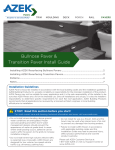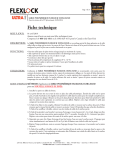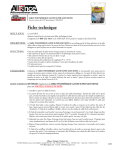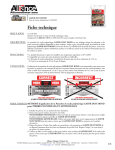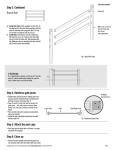Download AZEK A448-002 Instructions / Assembly
Transcript
ALL APPLICATIONS Installation Guidelines AZEK Pavers should be installed in accordance with the local building codes and the installation guidelines included below. AZEK Building Products, Inc. accepts no liability or responsibility for the improper installation of this product. AZEK Pavers may not be suitable for every application and it is the sole responsibility of the installer to be sure that AZEK Pavers are a fit for the intended use. Since all installations are unique, it is also the installer’s responsibility to determine specific requirements for each flat roof application. AZEK Building Products recommends that all applications be reviewed by a licensed architect, engineer or local building official prior to installation. Pages 1 - 3 Basic information on laying AZEK Pavers and designing a project for all applications Pages 4 - 5 Flat Roof Application Pages 6 - 8 Non-Permeable Landscape Application Pages 9 - 10 Permeable Landscape Application Page 11 Deck Resurfacing Application Page 12 Concrete Resurfacing Application IMPORTANT: Installation of AZEK Pavers is not recommended under the following conditions: • Do not install where standing, above-ground water conditions are anticipated. Proper sub base grading and other storm-water management designs should prevent the appearance of water at grade-level. In areas where small pooling occurs, adhesive can be used to affix the pavers to the grids to increase installation integrity. • Do not install where high volume vehicle traffic is expected (e.g. crosswalk). AZEK Pavers are designed for low volume, low speed vehicle traffic (e.g. driveways, parking lots). • Do not install for use as a fire pit. Grills and fire bowls may be used when placed over a fire mat to prevent any damage from burning embers. Please call AZEK Customer Service at (612) 234-8958 or visit our Support Center at support.azekpavers.com. EQUIPMENT NEEDED: NOTE: Some items are application specific • Landscape Applications Only o 4’ Level o Broom o Shovel o Metal Spikes o Hand or Vibratory Plate Compactor o (2) 3/4” Pieces of Conduit • Safety Glasses, Gloves, Ear Plugs • Marker • Hand Dolly • Edging • Caulking Gun • Adhesive - for recommended types, azekpavers.com/gluing • Utility Knife • Jigsaw or Miter Saw o 5-6 tpi jigsaw blade o 10” 24 tooth mitre saw blade o 12” 32 tooth mitre saw blade o azekpavers.com/cutting EXPANSION AND CONTRACTION AZEK Pavers will expand and contract with temperature change (similar to other composite materials). Below is a table with measures to account for this expansion. APPLICATION LANDSCAPE PAVER FLAT ROOF • Leave 1” gap between all damageable protrusions • Leave 1/2” gap between rigid protrusions LANDSCAPE • Leave 1” gap between all damageable protrusions • Place 4” concrete ribbon between pavers and asphalt RESURFACE N/A PERMEABLE PAVER RESURFACING PAVER N/A • Below 70˚F, leave a 5/8” gap between all protrusions. • Above 70˚F, leave a 1/2” gap between all protrusions • Leave 1” gap between all damageable protrusions • Place 4” concrete ribbon between pavers and asphalt N/A N/A • Below 70˚F, leave a 5/8” gap between all protrusions. • Above 70˚F, leave a 1/2” gap between all protrusions INSTALLING GRIDS AND PAVERS INSTALLING INSTALLATION GRIDS REMINDER: Installation grids must be orientated to allow the pattern of pavers to interlock grids in both directions. Please see back cover for more information. • Begin laying grids from the starting point of your choice. One example of cutting grids for optimal layout o Usually up against a structure, or the longest straight run. • Lay out approximately 10 grids to make room to install pavers. 16” Grid + 3” Grid 11” Grid + 8” Grid • As pavers are brought over and installed, the grids from those pavers will continuously be laid out across the install. • Grids can be cut to fit with the same cutting tools used for the pavers (e.g. mitre saw or jigsaw). o If the ending grid is less than 4”, cut off 4” or 8” of the grid before it, so the ending grids can be longer and will connect into the install with overlapping pavers (e.g. instead of a 16” grid and a 3” grid, create an 8” grid and an 11” grid). See example at right. PAGE 1 AVPIG_v2 01/13 Installation Guidelines ALL APPLICATIONS Installation Guidelines Page 2 of 3 Page 3 of 3 Choose Pattern: AZEK Pavers can be installed in a multitude of different patterns and combinations. Designs can include small and large repeating patterns. Some example patterns are provided below: LAY DOWN AZEK PAVERS • Bring stacks of pavers on the grids over to the starting point. • Empty pavers off of the grid. • Lay out initial installation grids based on desired pattern (using extra grids can reduce installation time). • Lay pavers using chosen pattern into the grids (mixing different colors if desired). • Doublecheck to make sure the grids are being connected by pavers in all directions. • Take empty grids and lay them out in the continued orientation needed for your pattern. • Continue laying pavers until all full pavers (i.e., not cut or trimmed) are installed. IMPORTANT: At least one paver must connect two grids in each direction. The herringbone pattern does this without needing to specially orientate the grids. Here is how the grids must be orientated to assure overlap in all directions for other patterns: Herringbone: This is the most popular and easiest to install pattern. Pavers will interlock grids in both directions. • Lay the installation grids as illustrated at right. • Start laying pavers at the starting corner. CUTTING INDIVIDUAL GRIDS AND PAVERS • Use the recommended cutting equipment (see page 1). For more info, visit azekpavers.com/cutting. • Cut pavers individually using a spare grid to hold it in place. Basketweave: This is the simplest installation method for a Basketweave pattern, but it will require extra installation grids. (Visit azekpavers.com/patterns to learn how to install without extra grids) • The starting paver must be laid 4” down and 4” over from the top left corner of the grid. This will shift the pattern over and assure at least one paver will connect two grids in both directions. • The leftover grid can either be trimmed off, or a 4” border can used to fill in the extra space. • For miter saws, short quick swipes with the blade works best. Keep the blade speed up and avoid binding. • Grids are cut similar to pavers; however, they cut easier due to their thickness. IMPORTANT: ALWAYS WEAR SAFETY GLASSES, GLOVES, AND EAR PLUGS WHEN TRIMMING PAVERS OR GRIDS. Obey all safety and operational instructions that came with your cutting equipment. DESIGN, PATTERN & COLOR CHOICE NOTE: AZEK Pavers allow for any shape installation, including straight and curved edges. Calculate Square-Footage: Measure the dimensions of the area to be resurfaced and calculate the total square footage. Be sure to add extra to the measured square footage to allow for scrap and to have a few extras on hand in case of future damage. Running Bond: This pattern will require the staggering of grids to assure the pavers will connect them in both directions. • The starting paver can be laid in the top left corner, but the next column of grids must be staggered halfway down the starting row. Every other column will need one half grid at the top. • Each half of the cut grid can be used. Calculate Amount of AZEK Paver Product Required: A unit of AZEK Pavers includes eight (8) pavers and one (1) 16.0” x 16.0” grid. The unit covers 1.78 square feet. To calculate how many units are needed, divide the total square footage of your project by 1.78. REQUIRED NUMBER OF UNITS PROJECT MEASUREMENTS (length x width = square feet) SINGLE COLOR TWO COLOR BLEND THREE COLOR BLEND 50 Sq Ft. 29 units 30 units (15 units each color) 30 units (10 units each color) 100 Sq. Ft. 57 units 58 units (29 units each color) 57 units (19 units each color) 250 Sq. Ft. 141 units 142 units (71 units each color) 141 units (47 units each color) 500 Sq. Ft. 282 units 282 units (141 units each color) 282 units (94 units each color) Pick Colors: AZEK Pavers come in five brilliant colors that can be used by themselves or combined to create unique blends. To help select the colors for your project, visit: PAGE 2 ALL APPLICATIONS MAINTENANCE Most stains, bird droppings, etc. can be cleaned using a garden hose. Tougher, embedded debris can be cleaned using a high-pressure sprayer and a mild detergent (similar to that used for cleaning your car). NOTE: Be careful when using a highpressure sprayer so as to not “etch” the paver surface or cause the pavers to dislodge. For further maintenance information please visit our Support Center at support.azekpavers.com. The techniques shown above should be used for best results. Results may vary as expansion and contraction could still occur, and drainage systems are unique to each landscape, deck or flat roof. AZEK Building Products, Inc. claims no liability or responsibility for the improper installation of this product. Since all installations are unique, it is the sole responsibility of the installer to determine specific requirements in regard to each flat roof application. AZEK Building Products, Inc. recommends that all designs be reviewed by a licensed architect, engineer or local building official before installation. Please contact AZEK Customer Service prior to installing if you have questions or concerns. www.azekpavers.com/color www.azekpavers.com/gallery AVPIG_v2 01/13 PAGE 3 AVPIG_v2 01/13 Installation Guidelines FLAT ROOF APPLICATION Installation Guidelines Page 1 of 2 FLAT ROOF APPLICATION Page 2 of 2 IMPORTANT: AZEK Pavers are a luxurious, low-maintenance covering that installs over an existing or new flat roof. AZEK Pavers are not a structural replacement for flat roof surfaces, and are not suited for all flat roof applications. Please consider wind-uplift and fire rating guidelines, along with the weight capacity of the roof when designing a project. Always consult your AZEK Representative for the recommended rooftop adhesion guidelines for your specific project. SUB-STRUCTURE REQUIREMENTS IMPORTANT: AZEK Pavers are designed to be a flat roof covering installed over a waterproofed, structural flat roof surface. AZEK Pavers are NOT a structural replacement for flat roof surfaces, and therefore, should NEVER be used as the structural element of the roof, as a ballast system, or in pedestal applications. Prior to installing, be sure to verify that the flat roof can support the addition of AZEK Pavers. • The roof structure must meet all required codes. • The system is designed for installation over a “low-sloped” roof (between 1/8” per foot and 1/2” slope per foot). • The rooftop surface must have adequate drainage to meet local codes. • The surface must be free from substantial undulations or “waves”. • Door and other thresholds must be able to accommodate the minimum added height. PAVERS ONLY (Installed on Grids) DRAINAGE MAT (American Wick SiteDrain 186) COMBINED HEIGHT (Pavers and Drainage Mat) RESURFACING PAVERS 1.75” 0.44” 2.19” LANDSCAPE PAVERS 2.38” 0.44” 2.82” IMPORTANCE OF SHEET DRAIN A drainage mat is required for flat roof applications over waterproofing membranes. It serves to both protect the membrane from abrasion and allows a pathway for water to escape to the drains. AZEK Pavers recommends using American Wick SiteDrain 186 or another comparable sheet drain. ADHERING PAVERS TO GRID In certain cases, pavers must be adhered to the grid for security (e.g. cut pavers, wind uplift conditions, around drains or where potential standing water could exist, stairs). Consult your AZEK Paver representative in all applications where wind uplift is a concern for recommendations. • Using a heavy-duty adhesive (see page 1) place a 1/8” bead across the top ribs of the grid. • Place the paver in the grid and press down firmly. • Let pavers sit undisturbed for duration of adhesive cure time. • A 28 oz. tube of adhesive will cover approximately 15 square feet. **Helpful Hint: For small undulations in the flat roof surface, scrap pieces of rubber membrane can be used as shims. This will help create a smoother top surface once the AZEK Paver system is installed. INSTALL SHEET DRAIN: IMPORTANT: Follow drainage mat manufacturers’ installation recommendations. • Roll out Sheet Drain with the length of the roll going with the slope of the roof (ensure it is flat and does not curl). • Rows of the Sheet Drain will abut one another. • Offset seams of the grids and seams of the drainage mat for best results. • Cut out the Sheet Drain around roof drains to allow water to escape. • DO NOT adhere the Sheet Drain to the waterproofing membrane. SECURING PERIMETER PAVERS Each application is different, and the perimeter must be secured accordingly. AZEK Pavers recommends adhering a minimum of 16” around the perimeter. For applications that do not end at a wall or parapet, a skirt board or trim board may work to cap off the unfinished edge of the paver system. Flashing may also be an option, and our system may be used in conjunction with other edging products if appropriate. Contact AZEK Pavers for further details. FINISHING THE PROJECT DO NOT SWEEP SAND IN PAVER JOINTS ON FLAT ROOFS AZEK Pavers should not be filled with joint sand when installed on a flat roof. For specific application questions please call (612) 234-8958 or email [email protected]. PAGE 4 AVPIG_v2 01/13 PAGE 5 AVPIG_v2 01/13 Installation Guidelines NON-PERMEABLE Installation Guidelines LANDSCAPE APPLICATION NON-PERMEABLE LANDSCAPE APPLICATION Page 1 of 3 SITE PLANNING AND MARKING IMPORTANT: Locate Utilities. Prior to beginning the installation, ensure all underground utilities (e.g. electrical lines, phone lines, water lines) have been properly located and identified. Mark Project Area: Once the project layout has been determined, mark or spray paint the overall outline, approximately twelve inches wider than the planned installation area. This will provide the additional excavation area needed for installing edging. Any pavers that abut structures or other paved areas will not require installed edging and therefore do not require the additional twelve inches of excavation. Page 2 of 3 INSTALL BASE MATERIAL AND SAND BED Install and Compact Base: • Add base material 2” at a time. • Compact each layer completely with a plate compactor or hand tamper. • Compact to 95% proctor density (ASTM D 698). • Be sure to compact all edges and corners thoroughly as these are at the most risk to degradation. • Limit any undulations to under 1/4” to limit any dips or humps in the final installation. IMPORTANT: Be sure to install base material at the proper slope. This should be approximately 1 inch over 6 feet to ensure sufficient water drainage. BASE MATERIAL DESIGN (Non-Permeable) IMPORTANT: The preparation of the site and base material is critical to a long lasting, flat and premium looking installation. Also, a properly prepared site will reduce installation time. Please contact a landscape professional if required. Install and Level Sand Bed: • Add a 3/4”to 1” layer of bedding sand. • Lay down two parallel pieces of conduit (3/4” or 1” diameter). • Place bedding sand between the two pieces of conduit and pull a screed board or straight edge down the conduit to level the sand out. • Add sand to areas that are uneven and re-level. • Pull the conduit out and fill in the area, leveling with a trowel or float. • Do not compact the bedding sand. Subgrade: The subgrade is the existing soil or surface that the installation will be built upon. Subgrades that are primarily clay or silt are the weakest subgrades and typically require additional base material. Geotextile: Geotextile material can be used to help prevent poor subgrade conditions from mixing with the base material. Heavy foot or vehicular traffic conditions are also good conditions for using geotextiles. The geotextile will be placed between the subgrade and the base material. IMPORTANT: Do not use sand to level depressions in the base layer. Instead, add base material to level the area. Base (Non-Permeable Applications): Base material should be a dense graded aggregate. Aggregate graded to 3/4” minus is a commonly used base material, often referred to as “class 5” or “road base.” Please refer to local requirements and specifications or ASTM D 2940 for further information. Do not use stone dust or screedings. Decide on Border / Soldier Course: The AZEK Paver system allows for several border and soldier course options. These can either be straight or curved. The accessory pavers can help limit the cutting and give a finished look to the project. IMPORTANT: These are general guidelines only and all base requirements vary by soil conditions, weather conditions, and other site-specific conditions. Areas that see freeze-thaw cycles or have wet, clay or silt type subgrades generally require a deeper base. Consult a landscape professional for more customized base recommendations. Patios, Walkways, Plazas, Other Foot Traffic 4 to 6 inches Driveways, Other Light Traffic 6 to 12 inches Parking Lots, Fire Lanes, Other Heavy Traffic Consult Landscape Professional The base material needs to be compacted every 2” as it is spread out. This will reduce any chance of the base material settling over time making the installation uneven. Additional resources for base design can be found at: ICPI Project Drawings (www.icpi.org) Slope: It is very important to slope the base in the direction that water is preferred to go. The typical slope is approximately 1 inch over 6 feet. Sand Bed: A layer of bedding sand is spread out on top of the compacted base material. This layer should be a maximum of 3/4” to 1”. This will create a workable surface for the pavers to be installed upon and will make it easier to make the installation even. • Use coarse sand that is washed and conforms to ASTM C 33. • Do not use mason sand, stone dust, or sands with excess fine particles. EXCAVATION: To install the necessary base material, the existing ground material must be taken out. To calculate how deep to excavate, add up these layers: Excavation Depth = Base Material Thickness + Sand Bed Thickness + 2.38” (Pavers) - 1/4” Once the excavation depth is known: • Excavate site to the appropriate depth. • Try not to disturb the subgrade beneath the required depth. • The subtraction of 1/4” leaves room for the sinking that occurs during the final compaction. • Level and compact the subgrade to a 95% proctor density (ASTM D 698) • Always have the compaction formally tested to ensure it meets the required standards. PAGE 6 AVPIG_v2 01/13 INSTALL BORDERS AND ACCESSORY PAVERS If the project requires curved or straight borders the accessory pavers can eliminate much of the cutting. These include legless full pavers and wedge pavers. • Draw the shape of the desired border onto the pavers that will need to be cut. Laying the accessory pavers on top of the other pavers and tracing the interior edge is the easiest. A string line may also be used. • Cut the pavers on the line in place using a jigsaw (do not cut through the grid). • Place the legless full and/or wedge pavers on top of installation grids to create the border. To calculate the number of full and wedge pavers needed for a given radius, visit azekpavers.com/accessories. • Use an adhesive between the accessory pavers and the grid (see page 1). PAGE 7 AVPIG_v2 01/13 Installation Guidelines NON-PERMEABLE Installation Guidelines LANDSCAPE APPLICATION Page 3 of 3 PERMEABLE LANDSCAPE APPLICATION Page 1 of 2 INSTALL EDGING Edge Restraints: AZEK Pavers require the use of an edge restraint around the perimeter. Edge restraints help keep the installation from moving, and perimeter pavers from tipping off the grid. The edging is generally staked down using 10 inch stakes, one every 6 to 12 inches. Plastic, aluminum, or concrete edging will work. PERMEABLE BASE MATERIAL IMPORTANT: A civil engineer, landscape professional, or local municipality, is recommended to design the appropriate permeable base. Each permeable application is different, and there are multiple considerations that must be taken into account (e.g. amount of rainwater, runoff water from hills and downspouts, soil type, the infiltration rate of the pavers). A permeable base is typically comprised of multiple layers of different sized fractured-face stones. The base material should be an open-graded aggregate, free from sands and other small particles. Please refer to local requirements and specifications, or visit ICPI.org for more information. Here is a generic permeable base found on the ICPI website. Edge restraints can be installed next to, or on top of, AZEK Installation Grids. For areas that will eventually be bordered by sod, or that have a curved perimeter, some installers may prefer to install edging over the top of the installation grids. If this is done, drill holes in the grid where the stakes will go. Top Layer (3/8” chip rock or No. 8 stone) 2 inches Middle Layer (1” stone or No. 57 stone) 4 inches Bottom Layer (2.5” stone or No. 2 stone) 6+ inches * Geotextile fabric optional between sub-base and bottom layer The base material needs to be compacted every 2” as it is spread out. This will reduce any chance of the base material settling over time making the installation uneven. Additional resources for base design can be found at www.icpi.org Slope: It is very important to slope the sub base (ground beneath the permeable base material) away from any building structures or foundations. The typical slope is approximately 1 inch over 6 feet. IMPORTANT: When installed up against asphalt, a 4” wide ribbon of concrete the depth of the base material is recommended. If abutted directly to asphalt, expansion of the AZEK Paver system may push the asphalt and cause it to buckle. Bedding Layer: The top layer is comprised of 1 1/2” to 2” of a 3/8“ clean, fractured-face rock. This will create a workable and permeable surface for the pavers to install upon. • Use a chip rock free from smaller particles (3/8“ chip rock or No. 8 stone). • Compact the bedding layer with a hand tamper or vibratory plate compactor. TAMPING PAVERS AND JOINT SAND The final steps to finish up the installation are a combination of tamping and sanding the pavers. This will even out small undulations and lock the pavers into place. Tamp (Compact) Pavers: Prior to sanding the pavers, use a vibratory plate compactor or a hand tamper to work the pavers into the sand bed. This will typically cause the pavers to sink approximately 1/4” into the bedding sand and will reduce small undulations. • A vibratory plate compactor will take one to two passes in both directions. • A hand tamper will require several strikes in each location. o Move around as you strike the pavers and make several passes. • The high undulated areas can be further tamped to even the surface. INSTALL BASE MATERIALS Install and Compact Base: • Add base material 2” at a time. • Compact each layer completely with a plate compactor or hand tamper. • Compact to 95% proctor density (ASTM D 698). • Be sure to compact all edges and corners thoroughly as these are at the most risk to degradation. • Limit any undulations to under 1/4” to limit any dips or humps in the final installation. IMPORTANT: Review the surface after tamping for any imperfections. If any are found, lift up the pavers and grid and either add or remove sand to make it level. Re-tamp the pavers after the imperfections have been removed. Install, Compact, and Level Bedding Layer: • Add a 1 1/2” to 2” layer of chip rock (3/8“ clean, fractured-face rock or No.8 stone) • Level the bedding layer appropriately and tamp with a hand tamper or vibratory plate compactor. • Add chip rock to areas that are uneven and smooth them out. Sweep in Joint Sand and Tamp Pavers: The same sand used for the sand bed can be used for the joint fill. This is a clean, sharp and well-graded coarse sand. Do not use overly fine sands; coarse sand will perform better. The standard specification for joint sand is ASTM C 33. • Start by spreading the sand across the pavers with a shovel. • Allow the sand to dry completely; this will make it easier to get into the joints. • Use a broom to spread the sand across the joints, sweeping in all directions. • Continue to spread and sweep the sand while tamping the pavers. o This can be done with a hand tamper or plate compactor. • When the joints appear to be filled to the desired level, sweep the installation clean of any remaining sand or dust. • The pavers will return to their original color once the pavers have been cleaned by rain. • Additional joint sand applications may be necessary after rain or settling of the joint sand occurs. IMPORTANT: Do not use polymeric sand with the AZEK Paver system. As the system expands and contracts it may cause the polymeric sands to break away from the edges of the pavers. PAGE 8 AVPIG_v2 01/13 PAGE 9 AVPIG_v2 01/13 Installation Guidelines PERMEABLE LANDSCAPE APPLICATION Installation Guidelines Page 2 of 2 TAMPING PAVERS AND JOINT FILL The final steps to finish up the installation are tamping and sweeping chip rock between the pavers. This will even out small undulations and lock the pavers into place. Tamp (Compact) Pavers: Prior to sweeping chip rock between the pavers, use a vibratory plate compactor or a hand tamper to work the pavers into the bedding layer. This will typically cause the pavers to sink approximately 1/4” into the bedding layer and will even out any small undulations. • A vibratory plate compactor will take one to two passes in both directions. • A hand tamper will require several strikes in each location. o Move around as you strike the pavers and make several passes. • The high undulated areas can be tamped down more to even the surface. IMPORTANT: Review the surface after tamping for any imperfections. If any are found, lift up the pavers and grid and either add or remove chip rock to make it level. Re-tamp the pavers after the imperfections have been removed. DECK RESURFACING APPLICATION Page 1 of 1 SUB-STRUCTURE REQUIREMENTS IMPORTANT: AZEK Pavers are designed to be a deck covering installed over a structural deck surface. AZEK Pavers are NOT a structural replacement for a deck surface, and should NEVER be used as the structural element of the deck. Prior to installing, be sure to verify that the deck can support the addition of AZEK Pavers. • The deck structure must meet and maintain all local codes. • Any existing deck boards must be flat and have no protruding or loose fasteners. • The boards should be made from rot / mildew resistant materials. o Consider using a water sealant where appropriate. • A 5/4” treated deck board is recommended for a new deck surface under the pavers. • Door and other thresholds must be able to accommodate the 1 3/4” added height. EDGING AND TRIM To secure the perimeter, there are a couple common methods: Use a 2 x 2 Piece of Trim: • End the AZEK Paver system two or more inches from the perimeter and place a piece of trim where the pavers do not abut the house. • Fasten the trim to the deck boards using deck screws or finishing nails. • Remember to leave the appropriate expansion gap between the pavers and the trim. o Refer to the “Account for Expansion” section above for more information. Sweep in Joint Fill: The same chip rock used for the bedding layer can be used for the joint fill. This is a 3/8“ clean, fractured-face stone. The standard specification for permeable joint fill is ASTM No. 8 stone. • Start by spreading the chip rock across the pavers with a shovel. • Using a broom spread the chip rock across the joints, sweeping in all directions. • When the joints appear to be filled to the desired level, sweep the installation clean of any remaining chip rock or dust. • The pavers will return to their original color once the pavers have been cleaned by rain. • An additional sweeping may be necessary after rain or settling of the joint fill occurs. • Do not tamp the pavers after the chip rock has been placed on the pavers. Use a Skirt Board Around the Perimeter: • A skid board can be installed around the open perimeters (not against the house). • Install the skirt board 1 3/4” above the deck surface to meet up with the height of the pavers. • Fasten the skirt board with the appropriate fasteners. • Remember to leave the appropriate expansion gap between the pavers and the skirt board. o Refer to the “Account for Expansion” section above for more information. IMPORTANT: Do not use sand or polymeric sand with the AZEK Permeable Paver system. COVERING STAIRS Deck stairs can be covered in a similar fashion as the deck surface, but a few more steps are needed. Screw Grids to the Stair Treads: In all stair applications it is required to fasten the grid to the stair tread with deck screws. • Use 1.5” deck screws. • Screw each grid to the stair tread with four screws, each placed approximately 2” in from the corners. Adhering Pavers to Grid: OPTIONAL: To reduce movement of the pavers, a heavy-duty construction adhesive can be used between the pavers and the grid. Some customers may prefer this in high traffic areas (e.g. outside of doors, at the top of steps). • Using a heavy-duty adhesive (see page 1) place a 1/8” bead across the top ribs of the grid. • Place the paver in the grid and press down firmly. • Let pavers sit undisturbed for duration of adhesive cure time. • A 28 oz. tube of adhesive will cover approximately 15 square feet. Edging and Trim: In a similar fashion as edging the surface of the deck, the stairs must also be edged to secure the pavers in place and give them a finished look. Use a Skirt Board for the Riser and Side Trim: • Run the skirt board up 1 3/4” above the deck surface to meet up with the height of the pavers. • Fasten the skirt board with the appropriate fasteners. Use a 2 x 2 Piece of Trim: • Run the trim around the entire of the tread. • Fasten the trim to the deck boards using deck screws or finishing nails. Do Not Sweep Sand in Paver Joints on Decks AZEK Pavers should not be filled with joint sand when installed on a deck. For specific application questions, please call (612) 234-8958 or email [email protected]. PAGE 10 AVPIG_v2 01/13 PAGE 11 v AVPIG_v2 01/13 Installation Guidelines CONCRETE RESURFACING APPLICATION Page 1 of 1 SUB-STRUCTURE REQUIREMENTS AZEK Pavers are designed to cover an existing hardscape free from major undulations. AZEK Pavers will contour to the surface in which they are resting, and will reflect any imperfections. the following techniques can be used to reduce undulations: • A self-leveling concrete or similar product can be used to fill in any low areas. • High areas can be knocked down and evened out to create a smooth surface. o It does not need to look good, as the resurfacing pavers will cover it. • Door and other thresholds must be able to support 1 3/4” added height. IMPORTANT: Water will flow out underneath the AZEK Paver system. The surface being covered should be sloped appropriately (typically 1 inch every 6 feet). EDGING THE PERIMETER To secure the perimeter, there are a couple common methods when the perimeter is up against a penetrable surface (e.g. dirt, grass): Use a Paver Restraint: • A paver restraint (e.g. plastic, aluminum) can be used around any perimeter not bordered by an existing structure. • Pound 10 inch metal spikes through the edging and into the ground every 6 to 12 inches. • Back fill up to the edging with dirt, sod, or other landscaping material. Use a Construction Adhesive: An alternative way to edge the pavers is to adhere the pavers to the grid 12” around the perimeter. Do not adhere the grid to the substructure. • Using a heavy-duty adhesive (see page 1) place a 1/8” bead across the top ribs of the grid. • Place the paver in the grid and press down firmly. • Let pavers sit undisturbed for duration of adhesive cure time. • A 28 oz. tube of adhesive will cover approximately 15 square feet. • Back fill up to the edge of the pavers with dirt, sod, or other landscaping material. For elevated concrete stoops or concrete steps please visit support.azekpavers.com for more information. Do Not Sweep Sand in Paver Joints FOR RESURFACING APPLICATIONS AZEK Pavers should not be filled with joint sand when used in a resurfacing application. For specific application questions, please call (612) 234-8958 or email [email protected]. PAGE 12 AVPIG_v2 01/13







